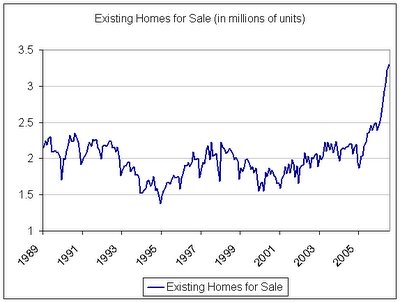One thing I've been closely watching is the potential for significant declines in credit quality. We all know mortgage lenders have been giving loans to anyone with a pulse. The subprime market has literally exploded, and as the overall market started slowing, lenders didn't pull in their horns. They just created more "affordability" products (40-year loans, option ARMs) and scraped the bottom of the credit barrel to keep loan volume humming.
Now, it looks like that is starting to come back to bite these companies. Take a look at Fremont General (FMT). Its shares are down in early trading on an earnings report rife with evidence of credit problems among its subprime borrowers. The full release is available
here. But let's look at a couple of excerpts, with the important passages in
bold ...
"The Company recorded these increased provision levels primarily as a result of
increased loan repurchase and re-pricing trends from its previous whole loan sale transactions, as well as lower secondary market pricing for second mortgages. These increased loan repurchase and re-pricing levels, which have been noted industry-wide, are
primarily due to increased levels of early payment delinquencies and a greater incidence of repurchase requests from whole loan purchasers. The Company's loan repurchases and re-pricings increased to $238.4 million during the second quarter of 2006, up from $67.7 million and $107.7 million for the second quarter of 2005 and the first quarter of 2006, respectively.
Given these loan repurchase and re-pricing trends, with an objective of reducing its early payment delinquencies,
the Company made modifications in its loan origination parameters during the second quarter of 2006, including eliminating or reducing certain higher loan-to-value products and lower FICO bands. The Company expects to see the impact of these changes during the fourth quarter of 2006 and the first quarter of 2007."
In non-industry jargon, FMT is saying that borrowers are in such bad shape, they're barely able to make their first couple of payments, much less hold onto their homes and pay their loans off longer term. FMT is also saying that the ultimate holders of these loans (wholesale investors and buyers of Mortgage-Backed Securities, or MBS) are getting antsy. They're paying less to buy loans in the secondary market and they're demanding that original lenders buy back some loans that they sold because they're going bad so fast.
This is a big red flag. And please note the OTHER block of text highlighted -- the lender, FMT, is now TIGHTENING lending standards. The government has been trying to get companies to do this for a long time. But they've stuck to namby-pamby "guidance," rather than actually cracked down. Now, the market is (belatedly) starting to do it for them.
Needless to say, this is all too little, too late. The time to raise standards and take steps to avoid future defaults was last year, when the housing bubble started bursting. There is virtually no way many lenders to borrowers with bad credit can avoid a big surge in delinquencies, foreclosures, and loan losses. That's the next big surprise on Wall Street, as I mentioned in a recent
Money and Markets email missive. And today's Fed meeting won't make ANY difference.
 Again, a picture is worth a 1,000 words. This is the quarterly housing affordability index produced by the National Association of Realtors. Notice anything funny? Housing hasn't been this unaffordable since the tail end of the 1980s. And that's with interest rates (long-term ones, anyway) not that far off their lows.
Again, a picture is worth a 1,000 words. This is the quarterly housing affordability index produced by the National Association of Realtors. Notice anything funny? Housing hasn't been this unaffordable since the tail end of the 1980s. And that's with interest rates (long-term ones, anyway) not that far off their lows.
 The verdict is still out of course. Maybe the rest of the economy will remain just fine and only the housing sector will suffer a recession. But color me skeptical.
The verdict is still out of course. Maybe the rest of the economy will remain just fine and only the housing sector will suffer a recession. But color me skeptical. 
